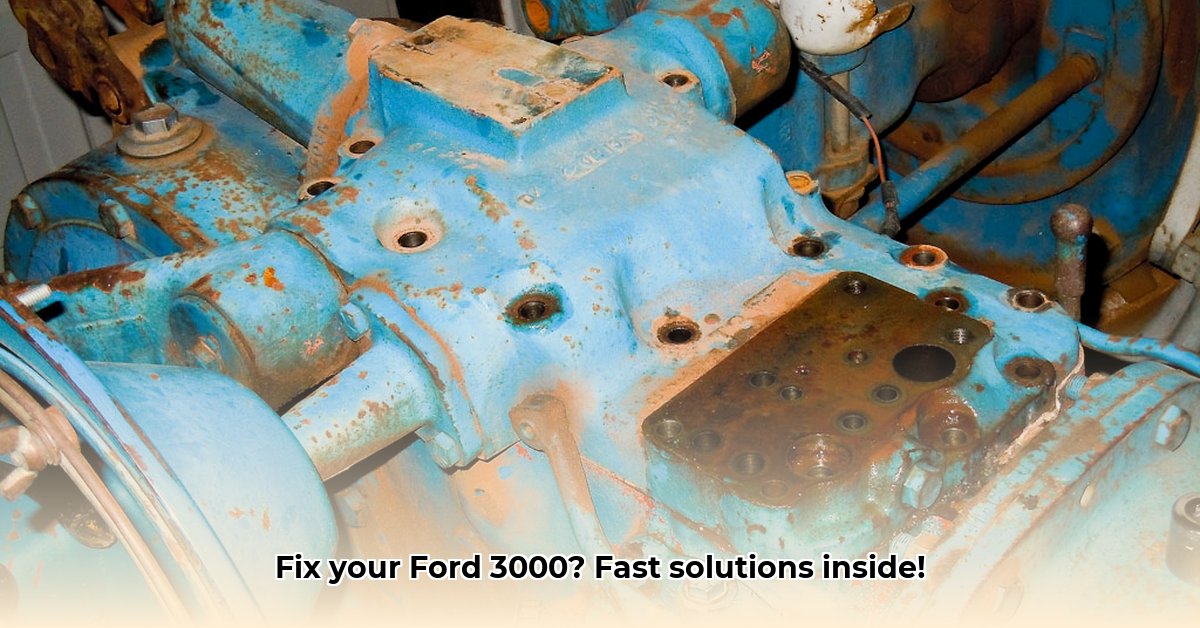
This comprehensive guide provides practical solutions and preventative maintenance strategies for common Ford 3000 tractor issues. Whether you're a seasoned mechanic or a weekend farmer, these step-by-step instructions will help you get your tractor back in top condition. For information on tires and rims, see this helpful resource: Ford 3000 Tires & Rims.
Starting Troubles: When Your Ford 3000 Won't Start
A tractor that refuses to start is frustrating. Here's a systematic approach to troubleshooting this common problem.
Battery Check: A weak battery is the most frequent culprit. Use a battery tester to check the voltage. Low voltage indicates the need for a recharge or replacement.
Starter Motor Diagnosis: A clicking sound suggests insufficient battery power. A grinding noise points to a faulty starter motor requiring replacement.
Fuel System Assessment: A clogged fuel filter restricts fuel flow. Inspect and replace the filter (located as per your owner's manual) if dirty or damaged. Check fuel lines for leaks or kinks. Also verify fuel reaches the injectors, potentially needing fuel pump inspection.
Spark Plug Examination: Remove and inspect spark plugs for soot (fouling) or wear. Replace any suspect plugs to ensure proper ignition.
Power Loss and Stalling: Unexpected Loss of Momentum
Losing power mid-task is disruptive. These are the most likely causes:
Fuel Filter (Again!): A clogged fuel filter severely restricts fuel flow. Regularly inspect and replace this crucial component.
Fuel Line Integrity: Inspect fuel lines for cracks, holes, or loose connections. Replace any damaged sections.
Fuel Injection Pump Malfunction: A failing fuel injection pump (often indicated by unusual noises or inconsistent operation) may require repair or replacement.
Air in the Fuel System: Air bubbles in the fuel lines disrupt fuel flow. Bleed the system—consult your owner's manual for specific instructions for your Ford 3000.
Overheating: Maintaining Engine Temperature
Overheating is serious. Preventative measures are key:
Coolant Level Monitoring: Low coolant leaves the engine vulnerable to overheating. Regularly check and replenish coolant (using the correct type).
Radiator Maintenance: A clogged radiator hinders heat dissipation. Regularly clean it (using a radiator cleaner or pressure washer) and check for leaks.
Fan Belt Condition: A loose or worn fan belt impairs the radiator fan's operation. Inspect for wear and ensure proper tension; replace if needed. Regular coolant flushes are also vital to prevent coolant degradation and system build-up.
Steering Issues: Maintaining Directional Control
Steering problems range from inconvenient to dangerous. Here's what to check:
Hydraulic Fluid Level: Low hydraulic fluid causes stiff steering. Check and replenish using the correct fluid type.
Power Steering Pump Assessment: A failing power steering pump (often generating unusual noises) may require professional attention or replacement.
Air in the Hydraulic System: Air in the hydraulic system can cause erratic steering. Bleeding the system is often necessary.
Preventative Maintenance: Proactive Tractor Care
Regular maintenance is vital for preventing costly repairs. Consider this essential schedule:
| Task | Frequency | Notes |
|---|---|---|
| Fluid Level Checks | Weekly/Monthly | Oil, coolant, hydraulic fluid, transmission fluid. |
| Fuel System Inspection | Monthly | Check fuel filter, lines, and connections. |
| Belt Inspections | Monthly | Check for wear and proper tension. |
| Comprehensive Fluid Changes | Every 6 Months | All fluids should be changed semi-annually. |
| Thorough Engine Inspection | Annually | Include spark plugs, air filter, etc. |
| Hydraulic System Check | Annually | Check for leaks, fluid level, and proper operation. |
How to Troubleshoot Ford 3000 Tractor Hydraulic System Leaks
Hydraulic leaks are common in older tractors. Here's a systematic approach to diagnosis and repair:
Key Takeaways:
- Worn seals and O-rings are frequent causes.
- Engine oil contamination points to a serious pump problem.
- Clogged filters are less common, but should be checked.
- Intermittent leaks often indicate pressure issues.
- Regular maintenance is crucial for prevention.
Identifying the Leak Source
Carefully inspect the entire hydraulic system for leaks, focusing on:
- Lift Cylinders: Check seals and O-rings for damage.
- Hydraulic Pump: Look for leaks and engine oil contamination.
- Hydraulic Reservoir Top Cover: Easy to spot and repair.
- Hoses and Fittings: Inspect for leaks at all connections.
- Valve Components: Check for damage or misalignment.
Note the leak's consistency; intermittent leaks usually mean pressure problems.
Troubleshooting Steps
- Visual Inspection: Thoroughly inspect for obvious leaks or damage.
- Fluid Level and Type: Verify correct fluid level and type.
- Filter Inspection: Inspect the hydraulic filters for clogging.
- Pressure Testing (if needed): Use a pressure gauge to pinpoint subtle leaks.
- Seal and O-ring Replacement: Replace damaged components with high-quality parts.
- Pump Inspection/Repair: Inspect or repair, potentially requiring professional assistance.
- System Cleaning: Flush the system to remove contaminants.
Preventative Maintenance
- Regular Fluid Changes: Follow manufacturer recommendations.
- Periodic Seal Inspections: Regularly inspect seals and O-rings for wear.
- Scheduled Filter Replacements: Replace filters as recommended.
Remember, safety is paramount. Consult a professional if unsure about any repair. Ignoring hydraulic leaks can lead to major problems.